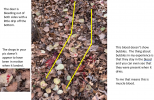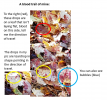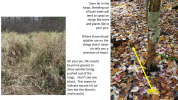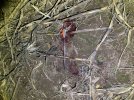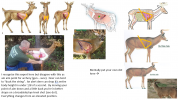In 2016 our family purchased 134 acres for hunting. We have had some great rifle hunting even though we have not had time to plant food plots. This last week I was out hunting with my crossbow. Tuesday, I shot a nice buck. Rolled it over at 20 yards. After a couple minutes he got up, I watched expecting him to fall over dead, but he walked away into the woods, no trace of blood. I searched for hours and hours, finally determined I must have hit it in the shoulder. Yesterday, same stand, I shot another buck at 10 yards. I was VERY careful to hit him in the power house. He ran 20 yards and stopped on the edge of the field. Blood was flowing from both sides (the arrow was in the ground, went through him). My wife and I searched for 6 hours and never found him, we tracked him to the edge of a brook, that was the last sign. I am quitting bow hunting. This is the 4th time this has happened to me in the past 3 years. I want a humane kill, and that doesn't seem possible with a crossbow. I would love to hear if I am doing something wrong or if others have had this experience
Failure to recover deer is part of hunting and ,even more so, bowhunting. I always fell sick at the stomach for a couple days after a failure to recover. However, we need to keep things in perspective. Every deer will die. Those not harvest by hunters will die of disease or predation, or being hit by a car. We a deer, or any animal dies, it goes back into the cycle of life. If you don't recover it and eat it, other wildlife will, and what is left will decay and go back into the soil nourishing plant life.
No one who has bene bowhunting long has a 100% recover rate. Here are a few things I've done and learned over the years.
1) Start by favoring a quiet bow over a fast one. No bow is fast enough to beat the speed of sound and the reaction time of a deer. You can't beat string jumping with speed.
2) Restrict yourself to short distance (20-30 yards) broadside or slightly quartering away shots.
3) keep your aim point slightly low (heart). If the deer doesn't jump the string, you will be fine. If it does, you still have a good chance of hitting lungs.
4) Don't ever give up looking for a deer on your own. Always get an experienced buddy (or wife) to join you. Don't quit until both people agree there is not chance of recovery.
5) It cost me a few thousand bucks, but I purchased a FLIR device. I have found deer using it by walking circles after loosing a blood trail that I never would have recovered without it. It has also really helped with a wounded deer. I've been able, using it, to spot a deer before bumping it. You can tell if they are alive using it. If so, I simply mark my spot and back out and go back the next day. Either the deer will die in that bed if not disturbed, or the wound was not fatal.
6) If your state allows it, a tracking dog, on a leash, can be an amazing way to recover deer when they blood trail ends.
7) Get a really bright flashlight (at least 2,000 Lumen) That is what I use by default. In tough cases consider a coleman type lantern. It seems to make blood "glow" and easier to see and identify than a flashlight.
8) Luminal is a pain to mixup, but can be effective for finding tiny amounts of blood.
We do everything we can to make a good shot, but we all make mistakes. Even when we do everything right, things beyond our control happen in the field. At some point, we need to rest on the knowledge that we have done our best.
